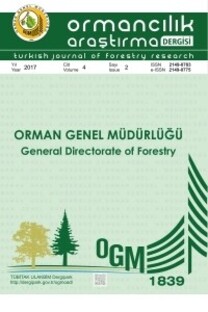Mersin ilindeki orman yangınlarının başlangıç noktalarına göre mekânsal analizi (2001-2013)
Orman yangını, mekânsal dağılım, hassasiyet analizi, Mersin ili
Spatial analysis according to start point of forest fires in Mersin province, Turkey (2001-2013)
Forest fire, spatial distribution, sensitivity analysis, Mersin province,
___
- BBaşaran, M. A., Sarıbaşak, H., Cengiz, Y., 2004. Yangın Söndürme Planı Temel Esaslarının Belirlenmesi (Manavgat Örneği), Batı Akdeniz Ormancılık Araştırma Müdürlüğü Teknik Bülten No:18, Antalya.
- Bilgili, E. and Goldammer, J.G. 2000. Fire in the Mediterranean Basin: Towards an interdisciplinary science programme. In proc. XXI IUFRO World Congress 2000, Forests and Society: The role of research, Vol.1, P.45-54.
- Bilgili, E. 2003. Stand development and fire behavior, Forest Ecology and Management Vol. 179, Issues 1–3, 3 July, p.333–339.
- Cáceres, C. F., 2011. Using GIS in Hotspots analysis and for forest fire risk zones mapping in the Yeguare Region, Southeastern Honduras. Papers in Resource Analysis, Volume 13, 14pp. Saint Mary’s University of Minnesota University Central Services Press. Winona, MN. http://www.gis.smumn.edu Retrieved (20.02.2014).
- Duran, C. 2012. Mersin ili orman alanlarının fizyografik özelliklere göre dağılımı. Uluslararası İnsan Bilimleri Dergisi (J-HumanSciences.com), 9 (1), 1-19.
- Duran, C. 2014. Relationship between rainfall distribution and physical geography elements within Mersin province, Turkey. Procedia-Social and Behavioral Sciences, 120 s.740-748.
- ESRI 2014. How Hot spot analysis: Getis-Ord Gi*
- ISSN: 2149-0783
- Yayın Aralığı: 2
- Başlangıç: 2014
- Yayıncı: -
Mersin ilindeki orman yangınlarının başlangıç noktalarına göre mekânsal analizi (2001-2013)
Farklı tohum kaynaklarının Sarıçam (Pinus sylvestris L.) tohum özelliklerine etkisi
Sevda POLAT, Osman POLAT, M. Doğan KANTARCI, Sedat TÜFEKÇİ, Yücel AKSAY
Ahmet İPEK, İsa SERTKAYA, Mustafa GEDİKLİ, Ömer CEYLAN, Hanife ERDOĞAN GENÇ, Mustafa AKBULUT, Hüseyin BAYKAL, Yusuf ŞAVŞATLI
Kumul ağaçlandırmalarının toprak agregatlaşmasına (k ırıntılanmasına) etkisi
